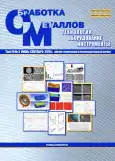Simulation of Atomic Mechanisms of Nucleation and Development of Plastic Deformation under Conditions of Shear Loading
- Authors: Nikonov A.Y.1
-
Affiliations:
- Issue: Vol 20, No 3 (2018)
- Pages: 97-108
- Section: MATERIAL SCIENCE
- URL: https://bakhtiniada.ru/1994-6309/article/view/302082
- DOI: https://doi.org/10.17212/1994-6309-2018-20.3-97-108
- ID: 302082
Cite item
Full Text
Abstract
About the authors
A. Yu. Nikonov
Email: anickonoff@ispms.ru
Ph.D. (Physics and Mathematics); Institute of Strength Physics and Materials Science SB RAS, 2/4 Prospect Akademicheskiy, Tomsk, 634055, Russian Federation; anickonoff@ispms.ru
References
- Scale invariance of structural transformations in plastically deformed nanostructured solids / V.E. Panin, A.V. Panin, Yu.I. Pochivalov, T.F. Elsukova, A.R. Shugurov // Physical Mesomechanics. – 2017. – Vol. 20, iss. 1. – P. 55–68. – doi: 10.1134/S1029959917010052.
- Oláh A., Croitoru C., Tierean M.H. Surface properties tuning of welding electrode-deposited hardfacings by laser heat treatment // Applied Surface Science. – 2018. – Vol. 438. – P. 41–50. – doi: 10.1016/j.apsusc.2017.10.090.
- Chemical treatment on aluminum alloy for hydrophobic surfaces / P. Sooksaen, O. Chulasinont, P. Janmat, W. Thovasakul // Materials Today: Proceedings. – 2017. – Vol. 4, iss. 5 (2). – P. 6528–6533. – doi: 10.1016/j.matpr.2017.06.163.
- Влияние основных параметров процесса сварки трением с перемешиванием на дефектность структуры сварного соединения / О.В. Сизова, А.В. Колубаев, Е.А. Колубаев, А.А. Заикина, В.Е. Рубцов // Обработка металлов (технология, оборудование, инструменты). – 2017. – № 4 (77). – С. 19–29. – doi: 10.17212/1994-6309-2017-4-19-29.
- Cold hole expansion effect on the fatigue crack growth in welds of a 6061-T6 aluminum alloy / K.C. Viveros, R.R. Ambriz, A. Amrouche, A. Talha, C. García, D. Jaramillo // Journal of Materials Processing Technology. – 2014. – Vol. 214, iss. 11. – P. 2606–2616. – doi: 10.1016/j.jmatprotec.2014.05.030.
- Reduction of the residual stresses in cold expanded thick-walled cylinders by plastic compression / V.F. Skvortsov, A.O. Boznak, A.B. Kim, A.Yu. Arlyapov, A.I. Dmitriev // Defence Technology. – 2016. – Vol. 12, iss. 6. – P. 473–479. – doi: 10.1016/j.dt.2016.08.002.
- Nikonov A.Y., Konovalenko I.S., Dmitriev A.I. Molecular dynamics study of lattice rearrangement under mechanically activated diffusion // Physical Mesomechanics. – 2016. – Vol. 19, iss. 1. – P. 77–85. – doi: 10.1134/S1029959916010082.
- Kuznetsov V.P., Tarasov S.Yu., Dmitriev A.I. Nanostructuring burnishing and subsurface shear instability // Journal of Materials Processing Technology. – 2015. – Vol. 217. – P. 327–335. – doi: 10.1016/j.jmatprotec.2014.11.023.
- Toward control of subsurface strain accumulation in nanostructuring burnishing on thermostrengthened steel / V.P. Kuznetsov, I.Y. Smolin, A.I. Dmitriev, S.Yu. Tarasov, V.G. Gorgots // Surface & Coatings Technology. – 2016. – Vol. 285. – P. 171–178. – doi: 10.1016/j.surfcoat.2015.11.045.
- Modeling of nanostructuring burnishing on different scales / A.I. Dmitriev, V.P. Kuznetsov, A.Yu. Nikonov, I.Yu. Smolin // Physical Mesomechanics. – 2014. – Vol. 17, iss. 4. – P. 243–249. – doi: 10.1134/S1029959914040018.
- Swirad S. The surface texture analysis after sliding burnishing with cylindrical elements // Wear. – 2011. – Vol. 271, iss. 3–4. – P. 576–581. – doi: 10.1016/j.wear.2010.05.005.
- Grzesik W., Zak K. Modification of surface finish produced by hard turning using superfinishing and burnishing operations // Journal of Materials Processing Technology. – 2012. – Vol. 212, iss. 1. – P. 315–322. – doi: 10.1016/j.jmatprotec.2011.09.017.
- Österle W., Dmitriev A.I., Kloß H. Does ultra-mild wear play any role for dry friction applications, such as automotive braking? // Faraday Discussions. – 2012. – Vol. 156. – P. 159–171. – doi: 10.1039/C2FD00117A.
- Exploring the beneficial role of tribofilms formed from an epoxy-based hybrid nanocomposite / W. Österle, A.I. Dmitriev, T. Gradt, I. Häusler, B. Hammouri, P.I. Morales Guzman, B. Wetzel, D. Yigit, G. Zhang // Tribology International. – 2015. – Vol. 88. – P. 126–134. – doi: 10.1016/j.triboint.2015.03.006.
- Li J., Chen S., Weng G.J. Significantly enhanced crack blunting by nanograin rotation in nanocrystalline materials // Scripta Materialia. – 2018. – Vol. 151. – P. 19–23. – doi: 10.1016/j.scriptamat.2018.03.030.
- Dynamic deformation and failure of ultrafine-grained titanium / Z. Li, B. Wang, S. Zhao, R.Z. Valiev, K.S. Vecchio, M.A. Meyers // Acta Materialia. – 2017. – Vol. 125. – P. 210–218. – doi: 10.1016/j.actamat.2016.11.041.
- Plimpton S. Fast parallel algorithms for short-range molecular dynamics // Journal of Computational Physics. – 1995. – Vol. 117. – P. 1–19. – doi: 10.1006/jcph.1995.1039.
- Dmitriev A.I., Nikonov A.Yu., Österle W. Molecular dynamics sliding simulations of amorphous Ni, Ni-P and nanocrystalline Ni ?lms // Computational Materials Science. – 2017. – Vol. 129. – P. 231–238. – doi: 10.1016/j.commatsci.2016.12.039.
- Development of new interatomic potentials appropriate for crystalline and liquid iron / M.I. Mendelev, S. Han, D.J. Srolovitz, G.J. Ackland, D.Y. Sun, M. Asta // Philosophical Magazine. – 2003. – Vol. 83. – P. 3977–3994. – doi: 10.1080/14786430310001613264.
- Stukowski A. Visualization and analysis of atomistic simulation data with OVITO – the Open Visualization Tool // Modelling and Simulation in Materials Science and Engineering. – 2010. – Vol. 18, iss. 1. – P. 15012. – doi: 10.1088/0965-0393/18/1/015012.
- Honeycutt J.D., Andersen H.C. Molecular dynamics study of melting and freezing of small Lennard-Jones clusters // The Journal of Physical Chemistry. – 1987. – Vol. 91, iss. 19. – P. 4950–4963. – doi: 10.1021/j100303a014.
- Stukowski A., Bulatov V.V., Arsenlis A. Automated identification and indexing of dislocations in crystal interfaces // Modelling and Simulation in Materials Science and Engineering. – 2012. – Vol. 20, iss. 8. – P. 085007. – doi: 10.1088/0965-0393/20/8/085007.
- Dmitriev A.I., , Nikonov A.Yu., Psakhie S.G. Atomistic mechanism of grain boundary sliding with the example of a large-angle boundary Sigma=5. Molecular dynamics calculation // Physical Mesomechanics. – 2011. – Vol. 14, iss. 1–2. – P. 24–31. – doi: 10.1016/j.physme.2011.04.004.
Supplementary files






